Aloo Baingan ki Sabji recipe is a simple and super easy preparation of dry savory and tangy dish made with eggplants, potatoes and spices. This flavorful and healthy Punjabi sabji recipe is a family recipe that I often make and is a variation of the Stuffed Eggplant that I have earlier posted. I am sure you will like this Aloo Baingan Recipe as much as we like. Vegan and gluten-free.
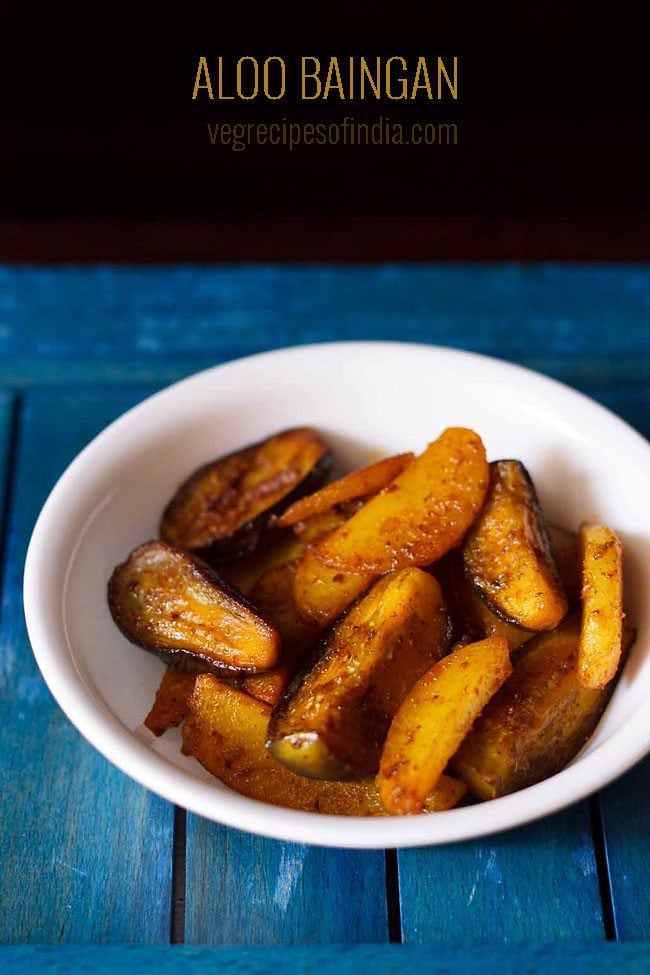
About Aloo Baingan Recipe
This is a dry dish where eggplants and potatoes are cooked in a mix of bold and tangy spices. Eggplants are also called as brinjals and aubergines. In Hindi language they are known as baingan or baigan. Aloo is the Hindi word for potatoes.
There are many ways you can make aloo baingan ki sabzi. We usually add potatoes in this dish to make it more filling and tasty. Of course if you are not fond of potatoes then either reduce the spices or increase the amount of eggplants.
Most varieties of small to medium sized eggplants work well in this dish. Avoid using the large variety of eggplant that we use to make Baingan Bharta as it can become mushy after cooking. The smaller varieties of eggplant are the best to be used in this recipe.
In this baigan sabji recipe, we simply slice or chop the aubergines instead of keeping them whole. Then mix them with the ground spices, seasonings and cook further on low heat.
I have used mustard oil in this recipe but even with a simple vegetable oil like sunflower oil the aloo baingan taste fabulous.
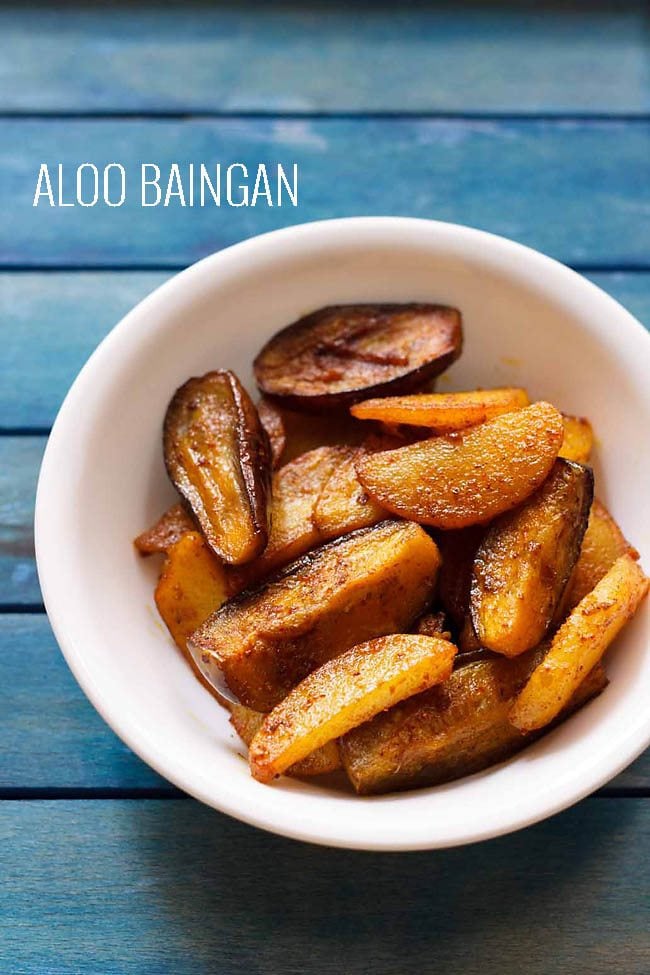
I have learned to make this recipe of aloo baingan sabji from my mother-in-law. Being a fantastic cook, my mother-in-law dishes out awesome Punjabi recipes.
Her trademark is that her recipes are easy to make and yet super yum. They are so easy that even a novice in cooking can make her recipes.
This aloo baingan is one such easy recipe. You can check more simple vegetable sabzi (veggie dishes) like:
You can enjoy this delicious aloo baingan with paratha, phulka and even with whole wheat bread. It makes for a perfect healthy side dish with dal rice or khichdi. You can also make it for tiffin box.
How to make Aloo Baingan ki Sabji
Before you begin to make this easy baigan ki sabji, you need to prep the vegetables. Use any variety of small to medium-sized eggplants but make sure they are fresh and tender. But the smaller variety or baby brinjals give a really good taste.
Preparation
For the potatoes you can regular potatoes or new potatoes or baby potatoes.
1. Wash the small brinjals and potatoes in fresh water a couple of times. Then slice each of the small brinjal into 4 pieces vertically. If the brinjal is of medium-size then first cut into half horizontally and then cut each half into 3 to 4 slices.
Keep the chopped brinjal in salted water for 15 to 20 minutes to remove their bitterness. You can add about ½ teaspoon of salt in a medium size bowl filled with water enough to cover the brinjals.
Note: It is better to soak the brinjals in salted water after cutting them. As this soaking gets rid of any bitterness in them.

2. Meanwhile peel 5 to 6 medium-sized potatoes. Then cut them into thin to medium-thin slices or wedges as shown in the below photo.

3. In a pan, heat 3 tablespoons of mustard oil or vegetable oil or any neutral flavored oil. Mustard oil gives a nice pungent aroma to this baigan sabji. I usually make this sabji with mustard oil.
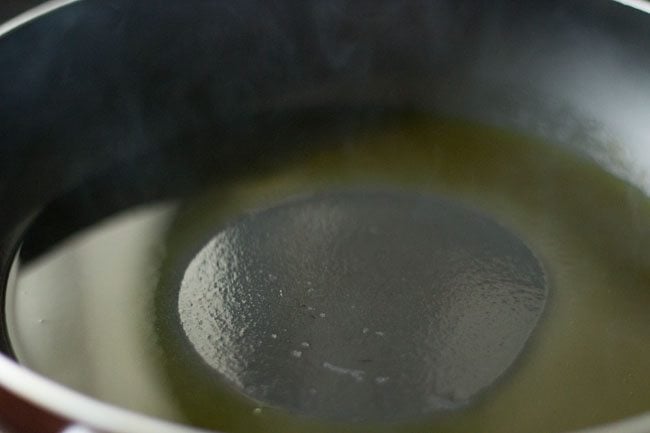
4. Add the potatoes to the oil. Keep the heat to medium-low to medium. Make sure that the pan is well seasoned so that the potatoes don’t stick on to it.
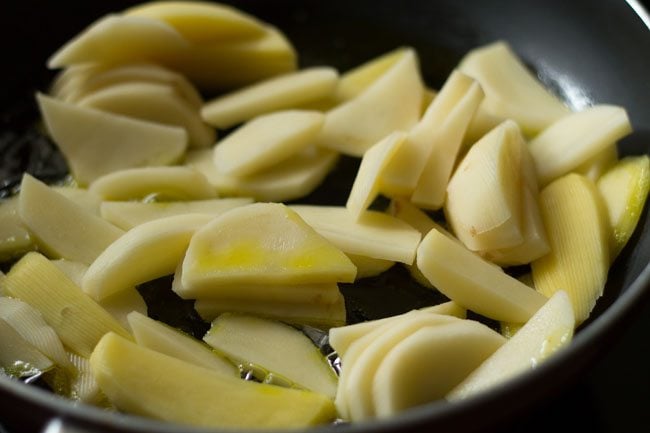
5. Next add the sliced brinjals.

6. Stir and mix well.

7. Saute in the oil for 4 to 5 minutes on a medium heat.

8. Add 2 teaspoons red chili powder, 1 teaspoon turmeric powder and salt as required. You can add regular salt or pink salt.

9. Mix the spice powders and salt evenly with the veggies.

Make Aloo Baingan Sabji
10. Now cover the pan with a lid and let the veggies cook on a low heat for 15 to 20 minutes.

11. In between keep checking the aloo baingan sabzi after a few minutes, so that the veggies do not stick to the bottom of the pan. Do stir occasionally.
If the aloo baigan gets stuck to the pan then add a splash of water. Mix well. Cover with lid and continue to cook on low heat.
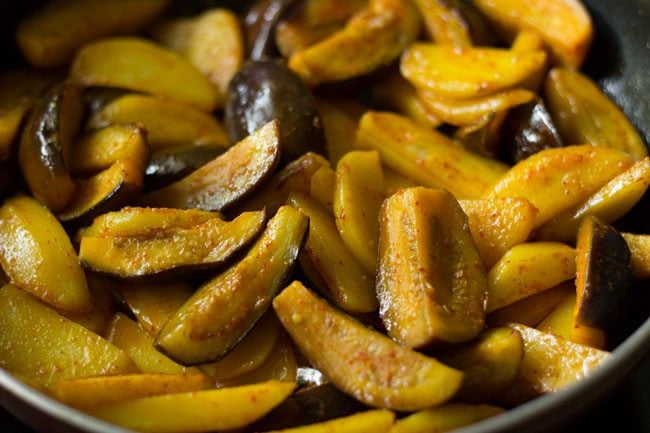
12. Here in below photo, the aloo baingan are cooked till fork tender and softened.
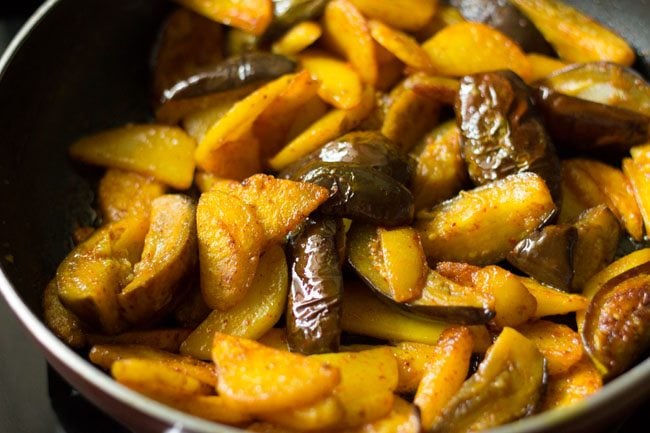
13. Once the veggies are cooked, then sprinkle 2 teaspoon garam masala powder and 2 teaspoon amchur powder (dried mango powder). The dry mango powder imparts a lovely tangy tasty to the sabzi.
If you don’t have dry mango powder then swap with 1 teaspoon of lemon juice.
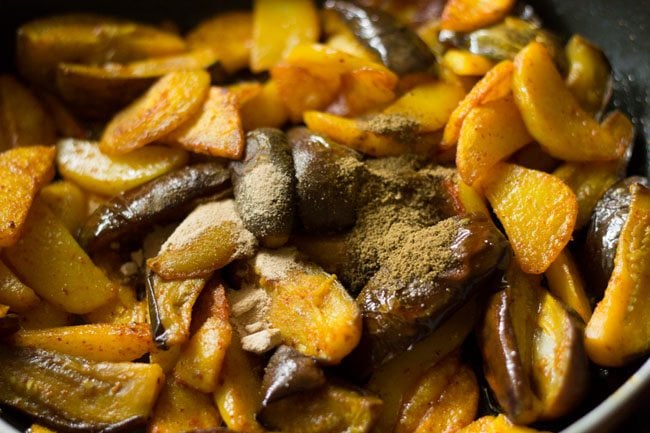
14. Mix well again.

15. Cook for a minute without the lid.
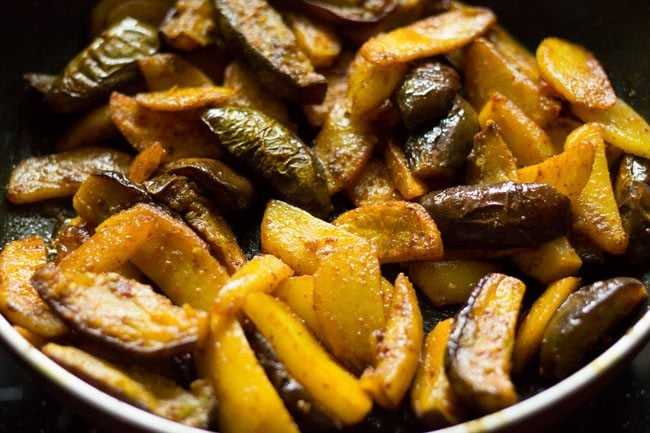
16. Close the heat and serve the aloo baingan sabji hot or warm with phulka or paratha accompanied with a side of dal, curd or raita of your choice.
It makes for a good dish to be packed in lunch box with a side of roti or whole wheat bread.
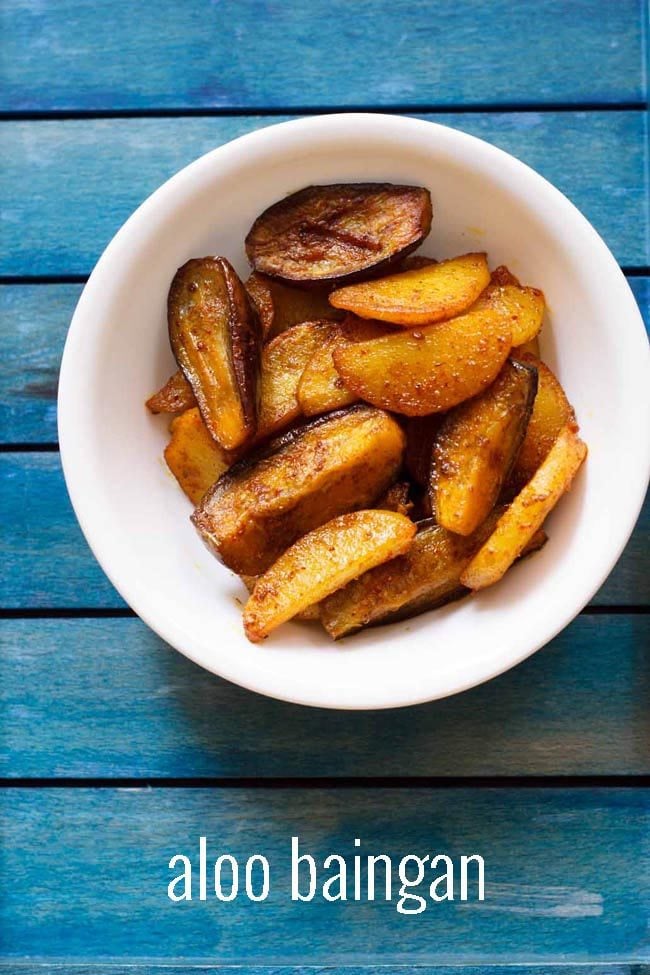
More Eggplant Recipes To Try!
Brinjal Recipes
Brinjal Recipes
Brinjal Recipes
Karnataka Recipes
Please be sure to rate the recipe in the recipe card or leave a comment below if you have made it. For more vegetarian inspirations, Sign Up for my emails or follow me on Instagram, Youtube, Facebook, Pinterest or Twitter.

Aloo Baingan Recipe (Punjabi Style)
Ingredients
- 1 kg small baingan (eggplants or brinjals)
- 5 to 6 potatoes – medium sized
- 2 teaspoon red chilli powder or paprika or cayenne pepper
- 1 teaspoon turmeric powder
- 2 teaspoon dried mango powder (amchur powder)
- 2 teaspoon Garam Masala
- 3 tablespoon mustard oil or vegetable oil
- salt or pink salt
Instructions
Preparation
- Wash the small brinjals and potatoes in fresh water a couple of times.
- Slice the brinjals into 4 pieces vertically. If the brinjal is of medium-size then first cut into half horizontally and then cut each half into 3 to 4 slices.
- Keep the brinjals in salted water for 15 to 20 minutes to remove their bitterness.
- Also slice the potatoes into thin to medium-thin wedges or slices.
Making aloo baingan ki sabji
- In a pan heat the mustard oil. Add the potatoes and brinjals to the oil.
- Saute in the oil for 4 to 5 minutes on a medium heat.
- Add red chilli powder, turmeric powder and salt as required.
- Mix the spice powders and salt evenly with both the veggies.
- Now cover the pan with a lid and let the veggies cook on low heat for 15 to 20 minutes.
- Keep checking the aloo baingan after a few minutes so that the veggies do not stick to the bottom of the pan. Do stir occasionally.
- When the aloo and baingan are cooked until fork tender and softened, then sprinkle garam masala powder and dry mango powder.
- Mix these thoroughly and cook for a minute without lid
- Close the heat and serve the aloo baingan sabji hot with phulka or paratha or whole wheat bread. It makes for an excellent side dish with dal rice or khichdi.
Notes
- Use fresh and tender brinjals. Preferably try to make this dish with a smaller variety of brinjals or eggplants. You can also use medium-sized brinjals. But avoid making with the larger variety of brinjals that we used to make baingan bharta.
- The regular potatoes, baby potatoes and new potatoes works well in this recipe.
- You can skip adding potatoes you want to only make baigan ki sabji. But then either increase the quantity of brinjals or reduce the spices according to your taste preferences.
- Make sure not to slice the potatoes thickly as they will be undercook by the time the brinjals are cooked. So slice them into thin or medium-thin wedges or slices.
- Mustard oil gives a good smoky and pungent flavor. But you can use any neutral flavored oil also.
- If you want you can garnish the aloo baigan with some chopped coriander leaves.
- The recipe can be scaled to make a smaller batch.
Nutrition Info (Approximate Values)
Aloo Baingan recipe from the archives was first published on April 2011.


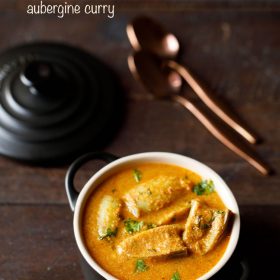


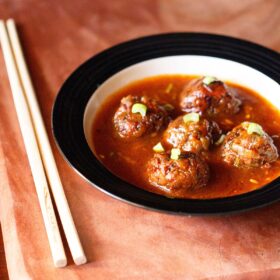
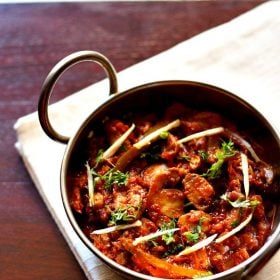
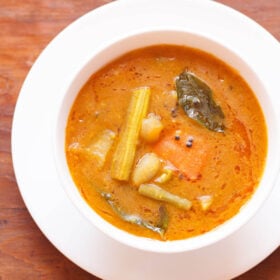








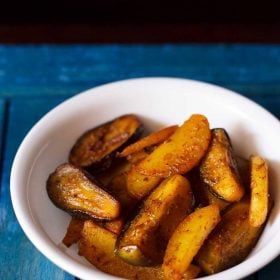
Dear Sister,
No Onion, No Tomato how will the potatoes n Brinjal Cook on their own without moisture. We need to either add Onion or Onion slice n Tomato or else the Brinjal and Aloo will end up uncooked or burnt
There is no need to add any onions or tomatoes in this recipe. This method of cooking uses the slow sauté technique and then followed by steaming. There are many veggies that are cooked using this sauté method and they do not get burnt and neither remain undercooked.
Amazing!
Thank you. I stay alone and rely heavily on your recipes to cook and survive 🙂
welcome and thanks for the lovely feedback.
Tastes good. ????
thanks.
Hi dassana
I didn’t add water but eggplants were not small instead of medium size.and to cook potato I had to cover the pan and brinjals got mushy.I think next time I would first cook potato and later on add brinjal then they might not get mushy….
fine. avoid covering the pan and then the steam is created from the water content of the veggies and they do become mushy. yes first cook potato till half or 3/4th done and then add the brinjals.
Hello ma’am…..
No water was added bt still it became mushy….
Vl try frying aloo,like ur aloo gobhi….may turn up gud….
Also,wanted to really really thank u for such lovely,wide ranged n awesome recipes…..wid 11 yrs of mrg,kitchen cud never hold me for more than 10 mins bt wid ur blog,I m realizing cooking really isn’t a rocket science and it’s all cz of u…..
Hv been trying lot many from ur blog…..
Keep growing n blessing us wid all talent n passion…
Regards
okay. thanks for letting me know pooja. next time you can add more oil and sauté or fry and make the sabzi. if the water content is more in the baingan, then also it will become mushy.
also thanks for the lovely comment. i am glad that the recipes are helping. i agree cooking isn’t a rocket science and with a bit of patience and practice one can make tasty food at home.
Hello ma’am…..
It turned mushy……
Can we keep frying aloo,like in aloo gobhi instead????
pooja, did you add any water? if these are cooked without water, they don’t become mushy. you can fry aloo also like it is done for aloo gobi.
Hi Dassana,
Made this today and was delicious just like all of your other recipes that i have made before.Rarely do i follow your recipe and it doesn’t turn out good.Thanks and as always do keep posting more and more such delicious recipes.
Love you and God bless.
Welcome Shernaz. Thanks for your positive feedback on recipes and also for your best wishes. Glad to read your positive words.
Hi dassana,
I tried this sabzi this morning but ran into some glitches while cooking..
1. Salt and haldi stuck to the bottom of the pan and kept getting darker with cooking time. I had to add 3-4 tbsp water to avoid any burning. But due to water addition, sabzi turned out more on softer side and not crispy
2. It took me 25 min, after covering, to get the veggies done.
Any suggestions or tips to avoid these next time?
I used a thick bottomed steel handi & substituted oil with ghee.
ruchi, this happens if the base of the pan or kadhai is not thick and heavy or the pan is light weight. so if possible if use heavy kadai or pan while cooking such kind of dishes. for making these recipes i have an old heavy kadai which i use. its both iron and aluminium made. avoid steel handi or kadai as even i have these thick bottomed handis but the veggies and spices always stick. so i use them to make sambar, dal or rasam or gravy based dishes. if using steel, then you can use tri ply or five ply steel. otherwise with the indian brands, the veggies do get stuck. also cook on a low flame and stir at intervals.
Thanks for this explanation, I was under impression that these steel pans are thick. I have an iron kadai. How do I season it before cooking veggies? Usually I use this iron kadai for making sweets only.
welcome ruchi. the steel pans that we get in india are not thick. they say it is sandwich bottomed etc, but still food gets burnt. i have seasoned the iron kadais which i use only once. after that since i cook often i have not seasoned them. i use them for deep frying as well as making dry veggie dishes. to season, heat the kadai on a low flame and spread some oil all over with a paper tissue or spoon. make a layer of oil. heat this layer and then wipe it with a paper tissue or cloth. again spread a layer of oil. switch off the flame and keep the pan with the oil layer on it for 2 to 3 days or a week. before using, heat the pan and wipe dry the previous oil layer. spread another layer. wipe dry this one also. then add oil and make the dish you want to.
Ok can I use mustard oil for seasoning? And after seasoning like this, shall i use this kadai only for veggies or i can cook sweets also occasionally (like making mawa, halwa) which involve lot of stirring, scratching?
You gave a very nicely detailed explanation for seasoning.
you can use any oil including mustard oil. of course you can use the same kadai for making halwa or mawa. i also use the same kadai for making sweets as well as sabzis. thanks ruchi.
Thank you for clarifying everything. This is one of the distinct features of your blog that you always respond..
Welcome Ruchi. Glad to help.
Thanks, Dassana. My son who never liked baingan sabji loved this recipe. Its yummy. I have followed many more reciepes of yours. They have turned out to be yummy. My friends just love it.
thanks a lot santosh. glad that your son liked the aloo baingan. usually in my home potato has to be be added in all sabzis. this way some of the veggie is consumed with the potatoes. otherwise with just the veggie, no one even has it ????
Hi Ma’am,
First of all, all the recipes are really good. Thanks for sharing them!
I have a query regarding this recipe. I’m currently in UK and when I tried making aloo baingan, it didn’t cook so well. I used the long baingans (but not big). The sabji sticks a lot to the pan and also doesn’t cook in the suggested time. And because I have to keep it on the flame longer, the baingans lose their texture.
That’s why I usually pressure cook the baingan & aloo and then add them to the oil. However that won’t taste as good as the pan version (and the baingan’s skin also comes off).
Is there anything u can suggest?
Sweta, use a well seasoned pan. i mean a pan which has been used often for making dishes like sabzis. the pan has to have a thick bottomed. so that the food does not stick and the veggies are cooked evenly. you have to stir also at regular intervals for even cooking. i usually use kadai or a cast iron skillet to cook sabzi’s like these. i smear the cast iron skillet with oil, when not in use. so that it is well seasoned. also it will help to cook on a low flame.
Thanks for the reply! Most things were as per your suggestion, except next time I’ll try a different pan (although this one was thick bottomed!!! ?) coz this one was an aluminum kadhai. Thanks once again.
Welcome Sweta. Do let me know your feedback once you try with new pan.
I have just starting cooking and im following your recipes and i must say they are like awsm and you use basic ingredients and they turn out to be magical. Thanks for sharing these recipes .
welcome jasleen, thank you for your kind and motivating words 🙂
U r just a wonderful cook awesome ,i have tried many of your recipes ,specially they are with pictures easy to cook,they are just fab,thanks a lot for sharing.
U r just awesome ,i have tried many of your recipes ,specially they are with pictures easy to cook,they are just fab,thanks a lot for sharing.
thankyou payal and you are welcome 🙂
thanks for the recipe!! loved it…
welcome and thankyou ankur 🙂